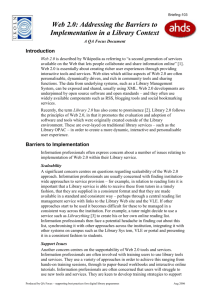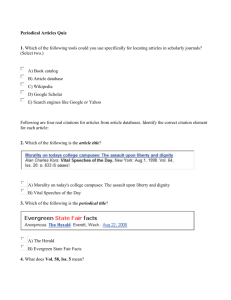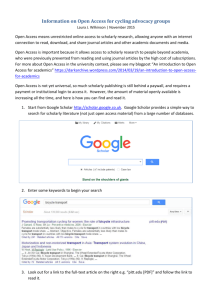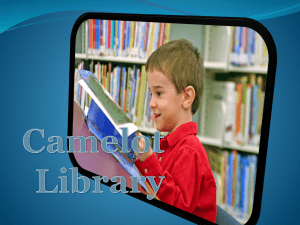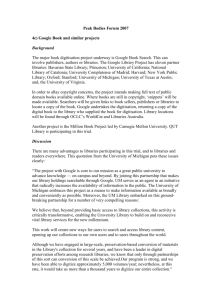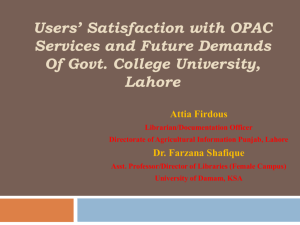Web 2.0: Supporting Library Users
advertisement
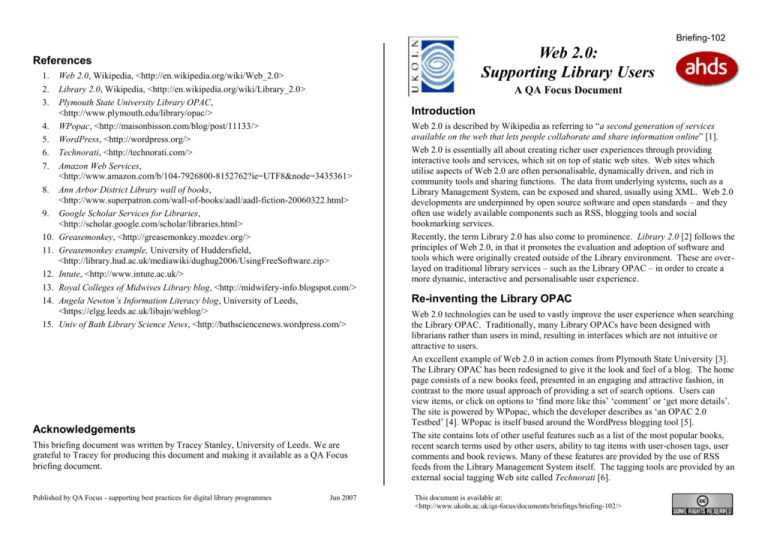
Briefing-102 Web 2.0: Supporting Library Users References 1. 2. 3. 4. 5. 6. 7. 8. 9. 10. 11. 12. 13. 14. 15. Web 2.0, Wikipedia, <http://en.wikipedia.org/wiki/Web_2.0> Library 2.0, Wikipedia, <http://en.wikipedia.org/wiki/Library_2.0> Plymouth State University Library OPAC, <http://www.plymouth.edu/library/opac/> WPopac, <http://maisonbisson.com/blog/post/11133/> WordPress, <http://wordpress.org/> Technorati, <http://technorati.com/> Amazon Web Services, <http://www.amazon.com/b/104-7926800-8152762?ie=UTF8&node=3435361> Ann Arbor District Library wall of books, <http://www.superpatron.com/wall-of-books/aadl/aadl-fiction-20060322.html> Google Scholar Services for Libraries, <http://scholar.google.com/scholar/libraries.html> Greasemonkey, <http://greasemonkey.mozdev.org/> Greasemonkey example, University of Huddersfield, <http://library.hud.ac.uk/mediawiki/dughug2006/UsingFreeSoftware.zip> Intute, <http://www.intute.ac.uk/> Royal Colleges of Midwives Library blog, <http://midwifery-info.blogspot.com/> Angela Newton’s Information Literacy blog, University of Leeds, <https://elgg.leeds.ac.uk/libajn/weblog/> Univ of Bath Library Science News, <http://bathsciencenews.wordpress.com/> Acknowledgements This briefing document was written by Tracey Stanley, University of Leeds. We are grateful to Tracey for producing this document and making it available as a QA Focus briefing document. Published by QA Focus - supporting best practices for digital library programmes Jun 2007 A QA Focus Document Introduction Web 2.0 is described by Wikipedia as referring to “a second generation of services available on the web that lets people collaborate and share information online” [1]. Web 2.0 is essentially all about creating richer user experiences through providing interactive tools and services, which sit on top of static web sites. Web sites which utilise aspects of Web 2.0 are often personalisable, dynamically driven, and rich in community tools and sharing functions. The data from underlying systems, such as a Library Management System, can be exposed and shared, usually using XML. Web 2.0 developments are underpinned by open source software and open standards – and they often use widely available components such as RSS, blogging tools and social bookmarking services. Recently, the term Library 2.0 has also come to prominence. Library 2.0 [2] follows the principles of Web 2.0, in that it promotes the evaluation and adoption of software and tools which were originally created outside of the Library environment. These are overlayed on traditional library services – such as the Library OPAC – in order to create a more dynamic, interactive and personalisable user experience. Re-inventing the Library OPAC Web 2.0 technologies can be used to vastly improve the user experience when searching the Library OPAC. Traditionally, many Library OPACs have been designed with librarians rather than users in mind, resulting in interfaces which are not intuitive or attractive to users. An excellent example of Web 2.0 in action comes from Plymouth State University [3]. The Library OPAC has been redesigned to give it the look and feel of a blog. The home page consists of a new books feed, presented in an engaging and attractive fashion, in contrast to the more usual approach of providing a set of search options. Users can view items, or click on options to ‘find more like this’ ‘comment’ or ‘get more details’. The site is powered by WPopac, which the developer describes as ‘an OPAC 2.0 Testbed’ [4]. WPopac is itself based around the WordPress blogging tool [5]. The site contains lots of other useful features such as a list of the most popular books, recent search terms used by other users, ability to tag items with user-chosen tags, user comments and book reviews. Many of these features are provided by the use of RSS feeds from the Library Management System itself. The tagging tools are provided by an external social tagging Web site called Technorati [6]. This document is available at: <http://www.ukoln.ac.uk/qa-focus/documents/briefings/briefing-102/> Book reviews and detailed descriptions are also provided from the Amazon Web site, and other Amazon services [7] such as ‘search inside’ and ‘tables of contents’ are also integrated into the site. Another interesting approach to the OPAC comes from Ann Arbor District Library (a US public library), who have created an online ‘wall of books’ using book jacket images [8]. Each image in the ‘wall’ links back to an item record in the Library OPAC. This is a novel approach to presenting and promoting library services, using an attractive ‘virtual’ library display to entice people into the OPAC for further information. Services Integration Google have provided a number of solutions for Libraries wishing to encourage their users to access local electronic and print resources when searching in Google Scholar [9]. Libraries can link their collections to Google Scholar to ensure that users are directed to locally-held copies of resources. The OCLC WorldCat database has already been harvested by Google Scholar, so that all the records in this database (a large Union Catalogue) are searchable via Google Scholar. Google is also offering its ‘Library Links’ programme which enables libraries using an OpenURL link resolver to include a link from Google Scholar to their local resources as part of the Google Scholar search results. Google Scholar users can personalise their searching by selecting their ‘home’ library as a preference. In order to set up integration with an OpenURL resolver, libraries simply need to export their holding from their link resolver database and send this to Google. Once set up, Google will harvest new links from the link resolver database on an ongoing basis. Library ’Mash-ups’ A mash-up can be described as a Web site which uses content from more than one source to create a completely new service. One example of a tool which can be used to support ‘mash-ups’ is Greasemonkey [10]. Greasemonkey is an extension for the Firefox Web browser which enables the user to add scripts to any external web page to change its behaviour. The use of scripts enables the user to easily control and re-work the design of the external page to suit their own specific needs. The University of Huddersfield have used Greasemonkey to enable local information to be displayed in Amazon when a user is searching Amazon [11]. The information is drawn from their Library OPAC – for example, users can be shown whether a particular title is available in the Library at Huddersfield, and can link back to the Library OPAC to see the full record. If the book is out on loan, a due date can be shown. This approach encourages users back into the Library environment to use Library services rather than making a purchase through Amazon. A New Approach to Resource Lists Intute is a free online service managed by JISC for the UK higher education community [12]. It provides access to a searchable catalogue of quality-stamped web resources suitable for use in education. It was previously known as the RDN (Resource Discovery Network). Intute can be used by libraries to create their own local lists of Web resources, thus reducing the need for libraries to maintain their own lists of useful Web sites for their users. Libraries can use the MyIntute service to create their own lists of resources drawn from the Intute catalogue. These can be updated on a weekly basis, if required, by creating weekly email alerts which identify new records added to the database which meet a stated set of criteria. The records can then be exported in order to present them on the libraries’ own Web site, using local branding and look and feel. Library staff can add new records to the Intute database if they find useful resources which have not already been catalogued in Intute. Supporting Users Blogs are increasingly used by libraries as promotional, alerting and marketing tools; providing a useful method of promoting new services, alerting users to changes and offering advice and support. The Library at the Royal College of Midwives [13] runs a blog to keep users informed about new service developments. Typical postings include information about new books received by the Library, pointers to content from electronic journals, news about new projects and services and other items which might usually be found in a Library newsletter. The advantage of the blog over a newsletter is that it is quick and easy to maintain and update, can therefore be kept more up-to-date, and can be integrated into the other services that the Library offers, through the Library Web site. Users can also choose to receive it as an RSS feed. At the University of Leeds, Angela Newton runs a blog which is aimed at supporting information literacy developments [14]. Angela’s blog is focused mainly at academic and support staff at Leeds who are interested in developing information-literate students. She focuses on a range of topics, such as assessment and plagiarism, academic integrity, use of information in education, research methods and e-learning tools. Angela’s blog is one of a number of ‘practitioner’ blogs at Leeds, and has been well received by the e-learning community within the institution. Another example is the “Univ of Bath Library Science News” service. In this example a blog service hosted at Blogspot.com provides “Updates for the Faculty of Science from your Subject Librarians: Linda Humphreys (Chemistry, Physics, Pharmacy & Pharmacology, Natural Sciences) Kara Jones (Biology & Biochemistry, Mathematics and Computing Sciences)” [15].
